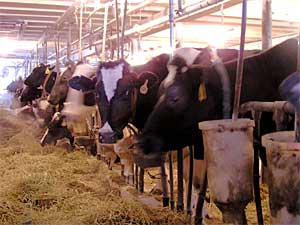|
Audio
Photos
Resources
Your Voice
|
Rural veterinarians in short supply
February 12, 2004
It's getting harder for farmers and ranchers in Minnesota to find a veterinarian when they need one. As older vets retire, there are fewer young vets who want to take over rural practices. It turns out more vet students are choosing to work on small animals in urban areas after graduation. The change has the state facing a shortage of vets who specialize in livestock.
Melrose, Minn. — The breath from 60 dairy cows steams up the morning air here in Dennis Ritter's central Minnesota barn. Ritter's cows are about to get a visit from a local vet.
Ritter needs a vet out here at least twice a month. He used to make a call and get a vet right away in the morning. But vets around here have become so busy, it's getting hard to find one quickly.
 | |||
"The other week I needed a vet out and he finally got here at 2:30. Then he had another call, so he left and sent in another vet at 4 o'clock to finish the work. Normally the surgeries would have been done in the morning," Ritter says.
A local vet has come today for what farmers call a "preg check." Dr. Sara Overby from Melrose is checking several in the herd to see if they're pregnant. Overby uses an ultrasound probe that produces a grainy picture on a small video screen, showing a calf in the womb of one cow.
Overby, 33, is tall, with her blonde hair pulled back in a pony tail. She's also splattered with manure.
"Being a large animal practitioner is not a glamorous job by any means, and it takes a lot of physical work," Overby says.
Overby also says it's fun. But it's difficult, messy work that isn't for everyone. She says it took two years to fill a recent opening for a vet in her office. As older vets retire, there just aren't enough young vets in the state interested in moving to rural areas and working with livestock.
It seems many vet students these days would rather work with smaller animals like dogs and cats.
 | |||
Dr. Jeffrey Nelson owns the Granite City Pet Hospital in St. Cloud. After graduating from vet school in 1999, he could have easily worked with livestock. But with small animals, Nelson can do the intricate medical procedures that fascinate him.
"It's the diagnostics -- the testing you can do, the hospitalization that we end up doing with the patients, and the treatment advances they keep coming up with. It's very interesting," Nelson says. Nelson admits the atmosphere at a small animal practice is more attractive for many vets. The work is indoors and the hours are consistent. The pay is better too.
That shift in interest among vet students has caught the attention of officials at the University of Minnesota Veterinary School. In 1993, 30 graduates were looking for large animal vet jobs. By 2002, that number was only 10.
Meanwhile the number of open positions stayed the same. In Minnesota, there are always about 50 positions available for large animal vets.
Jeff Klausner, dean of the vet school at the University of Minnesota, says part of the problem is the changing demographics of students.
 | |||
"It wasn't too many years ago that most of our students grew up on dairy farms, lived in small towns, and came to veterinary school to be dairy veterinarians, or food animal veterinarians, and then went back to those small towns," says Klausner. "Now it's more likely our students will come from Bloomington, Edina or Plymouth, and they're usually female, and they're often interested in small animal veterinarian medicine rather than food animal veterinarian medicine."
The U of M is trying to build up the number of large animal vets in the state. The vet school has increased its enrollment. And Dean Klausner says they recruit students, even in high school, who show an interest in large animal science.
The federal government is getting involved, too, by helping vet students with their school loans. The effort is modeled after federal programs to bring physicians to rural areas. The recently passed "Veterinary Health Enhancement Act" helps pay the loans of vet students who choose to work on livestock in rural areas.
|
News Headlines
|
Related Subjects
|

